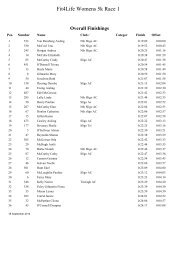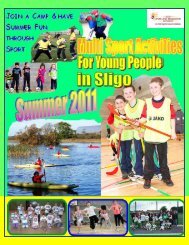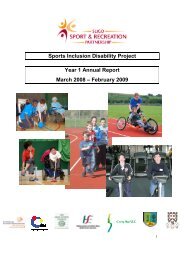Girls Active Programme - Sligo Sport and Recreation Partnership
Girls Active Programme - Sligo Sport and Recreation Partnership
Girls Active Programme - Sligo Sport and Recreation Partnership
You also want an ePaper? Increase the reach of your titles
YUMPU automatically turns print PDFs into web optimized ePapers that Google loves.
Findings<br />
that they seldom participated in physical activity<br />
before, i.e. those who used to be active for less<br />
than one day a week were most likely to increase<br />
their activity levels following participation in the<br />
initiative. The proportion of girls in this category<br />
dropped from 39% before involvement in <strong>Girls</strong><br />
<strong>Active</strong> to 23% afterwards. The median value for<br />
physical activity levels before starting <strong>Girls</strong> <strong>Active</strong><br />
is one day/ week <strong>and</strong> the median for afterwards is<br />
2-3 days/ week 19 .<br />
The girls indicated that <strong>Girls</strong> <strong>Active</strong> has been<br />
influential in any change in activity levels - more<br />
than half (54%) stated that the amount of physical<br />
activity they undertake now has been changed to<br />
some extent by their participation in <strong>Girls</strong> <strong>Active</strong><br />
(note that this physical activity is additional to <strong>Girls</strong><br />
<strong>Active</strong> itself). In addition, over a third of girls (36%)<br />
specifically indicated that they are now more<br />
involved in PE class as a result of participation in<br />
<strong>Girls</strong> <strong>Active</strong> (Fig. 6).<br />
Fig.6 - Impact of <strong>Girls</strong> <strong>Active</strong> on Participation<br />
in PE Class<br />
When asked to identify the barriers to taking up<br />
physical activity outside of <strong>Girls</strong> <strong>Active</strong>, the most<br />
common response was ‘no time’ (45%). The next<br />
most cited obstacles were ‘no facilities available’<br />
(20%), ‘not interested’ (20%) <strong>and</strong> ‘no friends<br />
involved’ (18%).<br />
4.1.8 Overall Experience<br />
<strong>Girls</strong> were presented with a number of factors<br />
associated with <strong>Girls</strong> <strong>Active</strong> <strong>and</strong> asked to rate each<br />
on a scale from ‘very important’ to ‘not important’.<br />
The majority considered that getting exercise <strong>and</strong><br />
having fun were the two most important factors<br />
– the median value for both was ‘very important’.<br />
A large secondary group of factors had a median<br />
score of ‘important’ - learning a new sport or skill,<br />
physical activity without competition, participation<br />
of friends, time to change clothes, no people<br />
watching, <strong>and</strong> meeting new people - while the<br />
remaining factors were considered by many to be<br />
‘neither important not unimportant’ - the fact that<br />
the activities did not involve physical contact, that<br />
there were no boys present, <strong>and</strong> that <strong>Girls</strong> <strong>Active</strong><br />
interfered with exams (details in Appendix D).<br />
4.1.9 Operation<br />
<strong>Girls</strong> were asked to indicate their level of satisfaction<br />
with several aspects of the operation of the<br />
programme. Most (more than two-thirds) indicated<br />
that they were either very satisfied or satisfied<br />
with the type, number <strong>and</strong> length of sessions, with<br />
costs <strong>and</strong> with instructors. More than half were<br />
also satisfied with the facilities provided <strong>and</strong> with<br />
the arrangements for transport home. All of these<br />
aspects of <strong>Girls</strong> <strong>Active</strong> registered a median score<br />
of ‘satisfied’ (details in Appendix E).<br />
4.1.10 Supports<br />
In response to a query regarding available support,<br />
the vast majority of respondents expressed a<br />
high level of satisfaction with the co-ordinating<br />
teacher (81% of girls registering ‘satisfied’ or ‘very<br />
satisfied’). <strong>Girls</strong> were generally also satisfied with<br />
the support from other <strong>Girls</strong> <strong>Active</strong> participants,<br />
other students in the school, <strong>and</strong> from their families.<br />
Satisfaction was most muted in relation to support<br />
from principals which 35% of girls rated as neither<br />
satisfactory nor unsatisfactory<br />
(details in Appendix E).<br />
4.1.11 Impacts<br />
<strong>Girls</strong> were asked to rate their level of agreement<br />
with a series of statements about the possible<br />
impacts of <strong>Girls</strong> <strong>Active</strong>. Most agreed or strongly<br />
agreed that they feel better (68%), are more active<br />
(64%), have learned new sports (61%) <strong>and</strong> are<br />
more aware of general health (64%) as a result<br />
of their involvement in the programme (all had a<br />
median value of ‘agree’, Fig. 7). While there was<br />
some indication from respondents that they feel<br />
more confident having participated in <strong>Girls</strong> <strong>Active</strong><br />
14<br />
Evaluation of the <strong>Girls</strong> <strong>Active</strong> <strong>Programme</strong> - 2003 – 2005 Report











